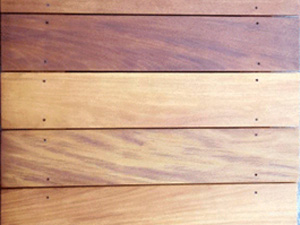Blonde and beautiful. The fun might last a while longer with the wood, though.
Common trade names: Brazilian Ash, Amarealao, Marotoa, Muiratua, Grapia.
Genus: Apuleia leiocarpa
Janka Hardness (pounds-force): 1650
Description: The lumber is derived from the genus of flowering legumes family, Fabaceae. Generally golden to fair brown in color, and its perceived hue can be quite affected by the effects of direct and indirect light. Interesting wood. Quite unique, however, and is much easier to work than Ipe or Cumaru.
Location: South America
Common Aliases: Brazilian Ash, grapia, Garrote, Muirajuba, Brazilian Oak. Garapa appears to have an identity crisis!
Performance: While easy to work, Garapa is a more or less generically scented wood that is fairly durable. Do not let anyone tell you Garapa is impervious to insects, because it isn’t. Nevertheless, it is a well above-average performing wood.
Acclimation: Garapa for an outdoor application should be kept on site, stacked and covered for one to three weeks prior to installation. Local climactic variations require a longer window.
Common Uses: Decks and docks, boats, exterior siding, and many other applications. We recommend to avoid direct ground contact with Garapa. Kiln dried Garapa will produce a sharp interior flooring, but remember that acclimation also applies to indoor installation projects!
From: The Wood Database
Garapa (Apuleia leiocarpa)
Common Name(s): Garapa
Scientific Name: Apuleia leiocarpa
Distribution: South America
Tree Size: 65-100 ft (20-30 m) tall, 3-5 ft (1-1.5 m) trunk diameter
Average Dried Weight: 52 lbs/ft3 (835 kg/m3)
Basic Specific Gravity: .66
Hardness: 1,650 lbf (7,320 N)
Rupture Strength: 17,020 lbf/in2 (117,340 kPa)
Elastic Strength: 2,163,000 lbf/in2 (14,920 MPa)
Crushing Strength: 9,140 lbf/in2 (63.0 MPa)
Shrinkage: Radial: 4.2%, Tangential: 7.5%, Volumetric: 11.7%, T/R Ratio: 1.8
